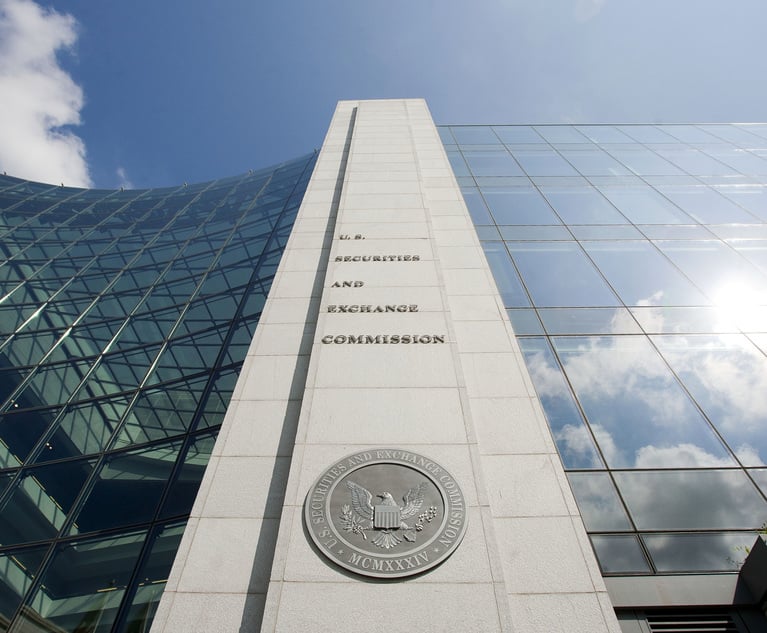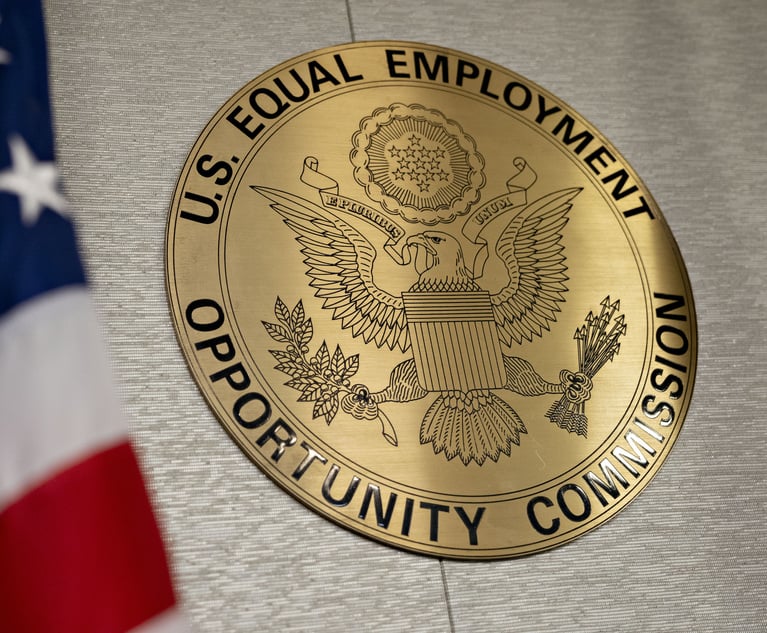Message Mayhem
Unified messaging presents one more worry in the e-discovery quagmire.
February 28, 2006 at 07:00 PM
7 minute read
You place a call on a landline and the telephone converts your voice into electric signals. Voicemail picks up on the other end. You leave a message, which the system converts into binary code. The answering machine automatically siphons the code, which takes the form of a .wav file, into the recipient's e-mail inbox as an attachment. The message sits in the recipient's inbox on the company's server. In a matter of seconds, what began as a human voice is transformed into an electronic document.
This is just one example of how unified messaging works. The technology is sweeping the corporate world because it offers a highly efficientway for users to access voicemails, faxes and e-mail all through the same electronic inbox for easy retrieval.
For in-house counsel, though, unified messaging may be creating more problems than it solves. While many GCs are just now learning how to grapple with the legal issues associated with e-mail, few have considered the legal problems associated with unified messaging.
“Any company that isn't keeping its eye on unified messaging is missing the ball,” says Brad Gross, a partner at Becker & Poliakoff's technology law group in Fort Lauderdale, Fla. “Legal counsel need to evaluate whether its uses create new baggage and how those uses can be dealt with to minimize liability.”
Audio Discovery
In-house counsel who haven't begun to evaluate the ramifications of unified messaging are doing more than missing the ball. They're living under a rock.
Corporate IT departments are integrating unified messaging into existing telecom systems at a steep rate. According to Gartner Research, an IT research firm, the number of shipments of unified messaging-capable systems increased 34 percent from 2004 to 2005.
“I would expect growth on the order of 20 to 25 percent in unified messaging in 2006 and likely even better in 2007,” says David Via, an analyst at San Francisco-based technology research institute Ferris Research.
With this rapid increase, legal departments aren't prepared to handle the major legal pitfalls of unified messaging. Companies previously were able to program traditional voicemail systems to delete messages after a few weeks or a month. Although an individual could always transcribe a voicemail or record it using a dictaphone, there wasn't any easy way to preserve it.
But this isn't the case with unified messaging. When the system converts a voice into an electronic file, it leaves behind a digital paper trail. And no longer are voicemails automatically deleted. Essentially, unified messaging turns voice messages into audio documents that companies can preserve and plaintiffs' lawyers can discover. Although no case law exists relating to the production of e-voicemails, most lawyers acknowledge these files are subject to discovery under the Federal Rules of Civil Procedure.
“Certainly we know voicemail is potentially discoverable, but there's been this kind of gentleman's agreement that lawyers don't go after it in discovery requests,” says Lori Wagner a partner at Redgrave Daley Regan & Wagner. “In the past it was largely because of accessibility, but with unified messaging that's no longer the case.”
Sound Searching
As a result, companies using unified messaging need to prepare themselves for a potential influx of e-voicemail discovery requests. And that's no easy task.
Over the past couple of years, software vendors have developed an array of solutions focused on helping companies cope with e-mail discovery issues. But few have jumped on the unified messaging bandwagon, leaving companies scrambling to figure out how to preserve, archive and search voicemails.
The biggest problem is searching. Although technology capable of scanning audio content for keywords is in the works, no reliable technology yet exists to review unified messages.
“Let's say an employer has 10,000 e-mails that are subject to discovery, and 20 percent are voicemail messages,” Gross says. “Twenty percent is thousands of e-mails that cannot be searched by keyword or subject matter. It's a problem.”
One solution is to draft a policy that not only governs what types of unified messages employees should keep, but also how they should save them. Employees should be instructed to name unified messages according to their subject matter. They also should be instructed to file or delete voicemails as soon as they are received. Additionally, users should mark privileged and nonprivileged information accordingly within folders. All of this will make it easier for counsel to locate and search relevant unified messages.
“Unlike e-mail, voicemail isn't self-evident,” Gross says. “Counsel need to demand that no voicemails should be stored unless they are labeled. Otherwise you are asking for a problem.”
Phone Etiquette
Another problem is controlling what employees say in outgoing messages now that voicemails are more likely to be stored long-term and are easier to distribute electronically. Whereas traditional voicemail systems confined voice messages to the office's system, unified messaging allows employees to easily forward voicemails as e-mail attachments or post them on the Internet.
This can create a huge headache for companies. Enraged employees who shoot off their mouths or an absent-minded executive who leaves privileged information in a voicemail could land the company in court.
In a 2004 incident, a Chicago associate at Winston & Strawn left a message on the voicemail of an associate at another firm. In the message he berates the lawyer for complaining about changes to a document. The following is an excerpt: “If you send one more f__king e-mail like this again, I can assure you your life on this deal is going to be very unpleasant ?? 1/2 If you can't be a monkey f__king scribe then ?? 1/2 let us do it.”
That message was then circulated around the Internet, much to the amusement and disgust of the law firm community. For many in-house counsel, though, the message was a vivid example of the dangers of unified messages.
“Corporate counsel feel like the little Dutch boy with his finger in the dike,” says Dennis Kennedy, a legal technology consultant in St. Louis. “Just when they thought they had everything covered under policy, something new arises.”
Although most in-house counsel most likely would rather keep unified messaging out of the workplace, that is unlikely to happen.
“Lawyers are concerned about how it plays into the litigation environment, but you don't want litigation to be the tail wagging the dog,” Wagner says.
——-
[Sidebar]
Caught on Tape
In the past, voicemail rarely came into play in courtrooms because it was automatically destroyed on a regular basis and therefore difficult to produce. But in a California lawsuit, a taped voicemail has taken center stage.
Whether a conversation accidentally recorded at the end of an August 2001 voicemail is admissible evidence has been the subject of a four-year legal battle in Jasmine Networks v. Marvell Semiconductor. In the disputed message, three Marvell officers, including the general counsel, forgot to hang up the speakerphone at the end of a message for Jasmine's in-house counsel and continued a conversation that Jasmine alleges outlines a plan to steal their trade secrets.
Marvell argued that attorney-client privilege protects the message. A trial court agreed and issued a preliminary injunction. Yet in April 2004, an appeals court threw out the injunction citing that the crime/fraud exception applied. The issue now stands before the state's Supreme Court, which has yet to rule on it.
This content has been archived. It is available through our partners, LexisNexis® and Bloomberg Law.
To view this content, please continue to their sites.
Not a Lexis Subscriber?
Subscribe Now
Not a Bloomberg Law Subscriber?
Subscribe Now
NOT FOR REPRINT
© 2025 ALM Global, LLC, All Rights Reserved. Request academic re-use from www.copyright.com. All other uses, submit a request to [email protected]. For more information visit Asset & Logo Licensing.
You Might Like
View All

Trending Stories
- 1Haynes and Boone Expands in New York With 7-Lawyer Seward & Kissel Fund Finance, Securitization Team
- 2Upstart Insurer That's Wowing Industry Hires AIG Legal Exec to Help Guide Global Expansion
- 3Connecticut Lawyers in Spotlight for Repping FBI Agents
- 4SEC Sued for Failing to Reveal Records Involving Simpson Thacher Attorney
- 5Lawsuit Accuses University of California of Racial Discrimination in Admissions
Who Got The Work
J. Brugh Lower of Gibbons has entered an appearance for industrial equipment supplier Devco Corporation in a pending trademark infringement lawsuit. The suit, accusing the defendant of selling knock-off Graco products, was filed Dec. 18 in New Jersey District Court by Rivkin Radler on behalf of Graco Inc. and Graco Minnesota. The case, assigned to U.S. District Judge Zahid N. Quraishi, is 3:24-cv-11294, Graco Inc. et al v. Devco Corporation.
Who Got The Work
Rebecca Maller-Stein and Kent A. Yalowitz of Arnold & Porter Kaye Scholer have entered their appearances for Hanaco Venture Capital and its executives, Lior Prosor and David Frankel, in a pending securities lawsuit. The action, filed on Dec. 24 in New York Southern District Court by Zell, Aron & Co. on behalf of Goldeneye Advisors, accuses the defendants of negligently and fraudulently managing the plaintiff's $1 million investment. The case, assigned to U.S. District Judge Vernon S. Broderick, is 1:24-cv-09918, Goldeneye Advisors, LLC v. Hanaco Venture Capital, Ltd. et al.
Who Got The Work
Attorneys from A&O Shearman has stepped in as defense counsel for Toronto-Dominion Bank and other defendants in a pending securities class action. The suit, filed Dec. 11 in New York Southern District Court by Bleichmar Fonti & Auld, accuses the defendants of concealing the bank's 'pervasive' deficiencies in regards to its compliance with the Bank Secrecy Act and the quality of its anti-money laundering controls. The case, assigned to U.S. District Judge Arun Subramanian, is 1:24-cv-09445, Gonzalez v. The Toronto-Dominion Bank et al.
Who Got The Work
Crown Castle International, a Pennsylvania company providing shared communications infrastructure, has turned to Luke D. Wolf of Gordon Rees Scully Mansukhani to fend off a pending breach-of-contract lawsuit. The court action, filed Nov. 25 in Michigan Eastern District Court by Hooper Hathaway PC on behalf of The Town Residences LLC, accuses Crown Castle of failing to transfer approximately $30,000 in utility payments from T-Mobile in breach of a roof-top lease and assignment agreement. The case, assigned to U.S. District Judge Susan K. Declercq, is 2:24-cv-13131, The Town Residences LLC v. T-Mobile US, Inc. et al.
Who Got The Work
Wilfred P. Coronato and Daniel M. Schwartz of McCarter & English have stepped in as defense counsel to Electrolux Home Products Inc. in a pending product liability lawsuit. The court action, filed Nov. 26 in New York Eastern District Court by Poulos Lopiccolo PC and Nagel Rice LLP on behalf of David Stern, alleges that the defendant's refrigerators’ drawers and shelving repeatedly break and fall apart within months after purchase. The case, assigned to U.S. District Judge Joan M. Azrack, is 2:24-cv-08204, Stern v. Electrolux Home Products, Inc.
Featured Firms
Law Offices of Gary Martin Hays & Associates, P.C.
(470) 294-1674
Law Offices of Mark E. Salomone
(857) 444-6468
Smith & Hassler
(713) 739-1250







